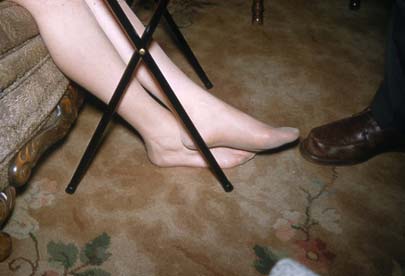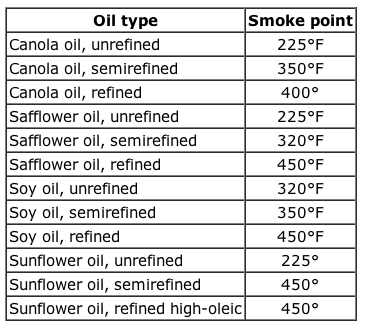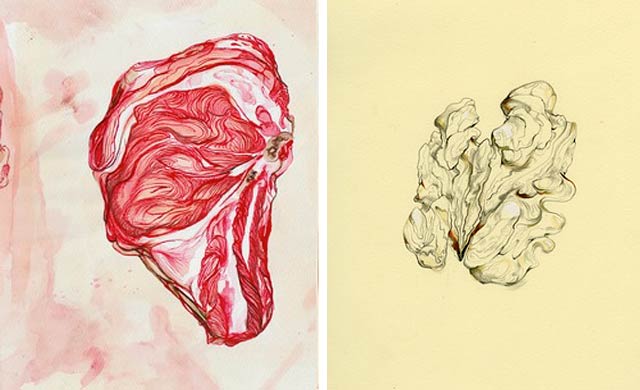health

An Irish jury awarded nearly $14 million in damages on Thursday to a man who claimed that his former employers had slandered him by insinuating that he had made improper advances to a female colleague during a business trip.
The man, Donal Kinsella, insisted that he had been sleepwalking during a trip to Mozambique in 2007 when he showed up, naked, at the door of a female colleague’s hotel room three times in one night, The Irish Times reported.
He later filed suit against the mining company that employed him at the time because it had referred to the incident in a press release explaining why he had been asked to resign from the company’s audit committee, on which the same female colleague served.
During the trial, the court heard that Mr. Kinsella had also been drinking and taking painkillers on the night in question.
{ NY Times | Continue reading }
law, pipeline, sex-oriented, sleep, weirdos | November 22nd, 2010 11:20 am

Older people may have always existed throughout history, but they were rare. Aging as we know it, and the diseases and disorders that accompany it, represent new phenomena—products of 20th century resourcefulness. When infectious diseases were largely vanquished in the developed world, few anticipated the extent to which chronic degenerative diseases would rise. We call them heart disease, cancer, stroke, arthritis, Alzheimer’s disease, and many more, but we might as well collectively use one word to describe them all—aging.
Aging may be defined as the accumulation of random damage to the building blocks of life—especially to DNA, certain proteins, carbohydrates, and lipids (fats)—that begins early in life and eventually exceeds the body’s self-repair capabilities. This damage gradually impairs the functioning of cells, tissues, organs, and organ systems, thereby increasing vulnerability to disease and giving rise to the characteristic manifestations of aging, such as loss of muscle and bone mass, decline in reaction time, compromised hearing and vision, and reduced elasticity of the skin. (…)
Humanity is paying a heavy price for the privilege of living extended lives—a new and much more complicated relationship with disease.
{ Slate | Continue reading }
related { Some animals live for 400 years. What can they teach us about extending life? }
photo { Misha De Ridder }
health, ideas, science, time | November 18th, 2010 4:14 pm

…areas of science, technology and medicine that are regressing. (…) I mean fields of research that actually go backward, as measured by some specific benchmark. Some examples:
* The end of infectious disease: Decades ago antibiotics, vaccines, pesticides, water chlorination and other public health measures were vanquishing diseases such as malaria, yellow fever, polio, whooping cough, tuberculosis and smallpox, particularly in First World nations. (…) Hopes for the end of infectious disease were soon crushed, however, by the emergence of AIDS, mutant flu viruses and antibiotic-resistant forms of old killers such as tuberculosis. (…)
* The origin of life: In 1953 Harold Urey of the University of Chicago and his graduate student Stanley Miller simulated the “primordial soup” in which life supposedly began on Earth some four billion years ago. They filled a flask with methane, ammonia and hydrogen (representing the primordial atmosphere) and water (the oceans) and zapped it with a spark-discharge device (lightning). The flask was soon coated with a reddish goo containing amino acids, the building blocks of proteins. This famous experiment raised the hopes of many scientists that one of nature’s deepest mysteries—genesis, the origin of life on Earth—would soon be replicated in the laboratory and hence solved. It hasn’t worked out that way. Scientists have failed to show how mere chemicals can become animate, and the origin of life now appears more improbable and mysterious than ever.
{ John Horgan/Scientific American | Continue reading }
artwork { Barnett Newman, The Promise, 1949 | Oil on canvas | Whitney Museum of American Art, New York }
health, mystery and paranormal, science, transportation, uh oh | November 17th, 2010 9:11 pm

He’s back in Iraq, on foot patrol, nervously walking down a street that suggests Basra, when it happens again—an explosion right across the street. The sidewalk shakes, he smells the acrid smoke, and as the panic starts to take over, his therapist says, “Turn right and walk up those stairs over there.” He goes up a stone stairway to the roof of a building and then watches the blast again, safely removed.
Only the client isn’t back in Iraq—he’s watching the scene unfold on a computer screen.
Therapists are making increasing use of virtual reality (VR) therapy, which, several studies suggest, increases the effectiveness of exposure therapy, the most empirically supported treatment for anxiety disorders such as PTSD and phobias.
A metanalysis in the April 2008 Journal of Anxiety Disorders found that VR is more effective than recalling memories exclusively through narrative, and just as effective as in vivo exposure for a wide range of anxiety disorders.
{ Psychotherapy Networker | Continue reading }
health, psychology, technology | November 16th, 2010 5:45 pm

Filing down horse teeth is a slobbery job. But Carl Mitz is grateful that he now has the undisputed legal right to do it.
This week, Mr. Mitz and three others won a three-year legal battle against the Texas Board of Veterinary Medical Examiners, which had sought to restrict the ancient craft of horse-teeth floating—an obscure job that involves filing a horse’s teeth to improve its bite—to licensed veterinarians. (…)
Texas, however, likely will continue to press the issue, meaning the victory could be fleeting. (…)
Horse-teeth floating is a lucrative job. Some practitioners say they can make $300,000 a year, and those who do it say it’s straightforward and requires no special training. But some veterinarians fear that unskilled floaters will damage the horse’s gums or strip away protective enamel.
{ Wall Street Journal | Continue reading }
photo { Audrey Corregan for Blend magazine, 2008 }
economics, health, horse, law | November 15th, 2010 6:48 pm

Sweating sickness, also known as the “English sweate” (Latin: sudor anglicus), was a mysterious and highly virulent disease that struck England, and later continental Europe, in a series of epidemics beginning in 1485. The last outbreak occurred in 1551, after which the disease apparently vanished. The onset of symptoms was dramatic and sudden, with death often occurring within hours. Its cause remains unknown. One suspect is a hantavirus. (…)
The symptoms and signs as described by Caius and others were as follows: The disease began very suddenly with a sense of apprehension, followed by cold shivers (sometimes very violent), giddiness, headache and severe pains in the neck, shoulders and limbs, with great exhaustion. After the cold stage, which might last from half an hour to three hours, the hot and sweating stage followed. The characteristic sweat broke out suddenly without any obvious cause. Accompanying the sweat, or after that was poured out, was a sense of heat, headache, delirium, rapid pulse, and intense thirst. Palpitation and pain in the heart were frequent symptoms. No skin eruptions were noted by observers including Caius. In the final stages, there was either general exhaustion and collapse, or an irresistible urge to sleep, which Caius thought to be fatal if the patient was permitted to give way to it. One attack did not offer immunity, and some people suffered several bouts before succumbing.
The malady was never seen again in England after 1578 although a similar illness, known as the Picardy sweat, occurred in France between 1718 and 1861, but was less likely to be fatal and was accompanied by a rash, which was not a feature of the earlier outbreaks.
The cause is the most mysterious aspect of the disease. Commentators then and now put much blame on the general dirt and sewage of the time, which may have harboured the source of infection. (…)
Relapsing fever has been proposed as a possible cause. This disease, which is spread by ticks and lice, occurs most often during the summer months, as did the original sweating sickness. However, relapsing fever is marked by a prominent black scab at the site of the tick bite and a subsequent skin rash, whereas contemporaries did not note these relatively obvious signs, so the identification is far from certain.
Chronic fatigue syndrome has been suggested by Chaudhuria and Behan based on a 1934 article of epidemic myalgia outbreaks that share clinical similarities with Bornholm disease.
More recently, a hantavirus has been proposed and appears to be an interesting candidate for consideration in the etiology of this illness.[4] However, certain clinical features of hantavirus outbreaks do not seem to match the progression of the sweating sickness; specifically, while hantavirus has only rarely been observed to be transmitted from one human to another, this is believed to be a significant mode of transmission of the sweating sickness.
{ Wikipedia | Continue reading }
photo { Helen Korpak }
flashback, health, mystery and paranormal | November 10th, 2010 5:20 pm

When we change our appearance, for example, by getting a haircut, friends will often note that we look different, but they may not be able to pinpoint exactly what has changed. This may result from our tendency to process faces holistically rather than by individual features.
In a recent study published in Psychological Science, volunteers were shown an image of a face or a house, followed by a similar image that may or may not have changed [images]. The volunteers were better at detecting that a change had occurred in faces than in houses, but they were surprisingly better at identifying which feature had changed in houses than in faces.
These findings suggest that holistic and feature-specific processing may be both advantageous and disadvantageous, depending on the nature of the task.
{ APS }
related { Questions about the safety of the latest sensation in hair care, the so-called Brazilian hair-relaxing treatment | NY Times | full story }
hair, psychology | November 4th, 2010 3:29 pm

Raymond Moore recently described a study about the influence of romance novels on condom use. Erotic romance as a genre generally focuses on spontaneous and passionate sex. Since rubbers don’t exactly scream passion, love scenes rarely mention their use.
Researchers at Northwestern University were interested in how novels affected attitudes toward condom use in readers. They surveyed college students about their reading habits and found that students who read more romance novels had more negative attitudes towards condom use and less intention to use condoms.
{ Livia Blackburne | Continue reading }
photo { Barnaby Roper }
books, health, psychology, sex-oriented | November 4th, 2010 2:41 pm

Americans less healthy than English, but live as long or longer, study finds
Researchers found that while Americans aged 55 to 64 have higher rates of chronic diseases than their peers in England, they died at about the same rate. And Americans age 65 and older — while still sicker than their English peers — had a lower death rate than similar people in England, according to findings published in the journal Demography. (…)
“If you get sick at older ages, you will die sooner in England than in the United States,” Smith said. “It appears that at least in terms of survival at older ages with chronic disease, the medical system in the United States may be better than the system in England.”
{ EurekAlert | Continue reading }
economics, health | November 4th, 2010 12:00 am

At the forefront of early psychedelic research was a British psychiatrist by the name of Humphry Osmond (1917-2004). In 1951, Osmond moved to Canada to take the position of deputy director of psychiatry at the Weyburn Mental Hospital and, with funding from the government and the Rockefeller Foundation, established a biochemistry research program. The following year, he met another psychiatrist by the name of Abram Hoffer. (…)
The pair hit upon the idea of using LSD to treat alcoholism in 1953, at a conference in Ottawa. (…)
By 1960, they had treated some 2,000 alcoholic patients with LSD, and claimed that their results were very similar to those obtained in the first experiment. Their treatment was endorsed by Bill W., a co-founder of Alcoholics Anonymous who was given several sessions of LSD therapy himself, and Jace Colder, director of Saskatchewan’s Bureau on Alcoholism, who believed it to be the best treatment available for alcoholics.
Osmond also “turned on” Aldous Huxley to mescaline, by giving the novelist his first dose of the drug in 1953, which inspired him to write the classic book The Doors of Perception. The two eventually became friends, and Osmond consulted Huxley when trying to find a word to describe the effects of LSD. Huxley suggested phanerothyme, from the Greek words meaning “to show” and “spirit”, telling Osmond: “To make this mundane world sublime/ Take half a gram of phanerothyme.” But Osmond decided instead on the term psychedelic, from the Greek words psyche, meaning “mind”, and deloun, meaning “to manifest”, and countered Huxley’s rhyme with his own: “To fathom Hell or soar angelic/Just take a pinch of psychedelic.” The term he had coined was announced at the meeting of the New York Academy of Sciences in 1957.
LSD therapy peaked in the 1950s, during which time it was even used to treat Hollywood film stars, including luminaries such as Cary Grant.
LSD hit the streets in the early 1960s, by which time more than 1,000 scientific research papers had been published about the drug, describing promising results in some 40,000 patients. Shortly afterwards, however, the investigations of LSD as a therapeutic agent came to an end.
{ ScienceBlogs/Neurophilosophy | Continue reading }
photo { Lina Scheynius }
Linguistics, drugs, flashback, ideas, science | November 1st, 2010 7:55 pm

The World Health Organisation’s ICD-10 manual of diseases and health problems has a diagnosis of ‘Strange and Inexplicable Behaviour.’ (…)
R46.0 Very low level of personal hygiene
R46.1 Bizarre personal appearance
R46.2 Strange and inexplicable behaviour
(…)
R46.6 Undue concern and preoccupation with stressful events
R46.7 Verbosity and circumstantial detail obscuring reason for contact
{ MindHacks | Continue reading }
health, weirdos | November 1st, 2010 5:30 pm

The kymograph was invented by Carl Ludwig in 1847.
P. van Bronswijk argues that the kymograph was the first recording device used to record and compare the influence of drug effects. Specifically, the kymograph enabled the study of the influence of drugs on a specific organ, which van Bronswijk says enabled the development of Pharmacology as an independent science in its own right.
{ History of Psychology | Continue reading }
photos { 1. Jacques André Boiffard, 1929 | 2. Paige de Ponte }
drugs, flashback, halves-pairs | November 1st, 2010 4:32 pm

In her new documentary, Picture Me, Columbia University student Sara Ziff chronicles her 4-year rise and exit through the fashion modeling industry, zooming her personal camcorder onto supposedly systemic abuses—sexual, economic, and emotional—suffered by fashion models. Among the many complaints launched in the film is an aesthetic that prizes uniformly young, white, and extremely thin bodies measuring 34-24-34” (bust-waist-hips) and at least 5’10” in height. It’s an aesthetic that many of the models themselves have a tough time embodying, pushing some into drastic diets of juice-soaked cotton balls, cocaine use, and bulimia—in my own interviews with models I discovered similar, but not very common, practices of Adderall and laxative abuse.
It’s also an aesthetic that has weathered a tough media storm of criticism, set off in 2005 with the anorexia-related deaths of several Latin American models, and which culminated in the 2006 ban of models in Madrid Fashion Week with excessively low Body Mass Indexes (BMI). And yet, as a cursory glance at the Spring 2011 catwalks will reveal, thin is still in.
In fact, bodies remain as gaunt, young, and pale as they did five years ago, and it’s entirely likely that in another five years models will look more or less the same as they do now.
What’s the appeal of an aesthetic so skinny it’s widely described by the lay public as revolting?
{ Ashley Mears/Savage Minds | Continue reading }
photo { Hedi Slimane }
fashion, health, horror | October 31st, 2010 8:34 am

The physiology of the dream state may be one reason why sexual content is so often reported. In the REM state, our muscles are in paralysis but the body is in a state of excitement. Even though sleep paralysis doesn’t feel like a dream, it has been shown in the lab that the expeirence occurs during REM intrusion after awakening or just after falling asleep. In REM sleep, whenever it occurs, men typically get erections, and women’s genitalia become engorged. Orgasms have been documented countless times in dream labs, and in sexual lucid dreams it is possible to experience orgasm too. Dreaming sleep is simply a sexy place to be.
Even when we are scared, and sometimes because we are scared, sexual excitement does not diminish. Sexuality and terror are deeply intertwined, neurologically speaking. So it’s not that outlandish to believe the medieval court documents in which men tell of being forced to have sex with mysterious she-demons and witches, even though this testimony was used in service of misogyny and the destruction of indigenous religious practices.
{ Dream Studies | Continue reading }
An incubus (from the Latin, incubo, or nightmare) is a demon in male form who, according to a number of mythological and legendary traditions, lies upon sleepers, especially women, in order to have sex with them. Its female counterpart is the succubus.
An incubus may pursue sexual relations with a woman in order to father a child, as in the legend of Merlin. Religious tradition holds that repeated intercourse with an incubus or succubus may result in the deterioration of health, or even death.
{ Wikipedia | Continue reading }
sex-oriented, sleep | October 28th, 2010 10:29 am

Is it OK to cook with extra-virgin olive oil?
One of the main things to consider when evaluating whether it is OK to heat extra-virgin olive oil (or any other oil for that matter) is the smoke point of the oil. The smoke point is the temperature at which visible gaseous vapor from the heating of oil becomes evident. It is traditionally used as a marker for when decomposition of oil begins to take place. Since decomposition incurs chemical changes that may not only result in reduced flavor and nutritional value but also the generation of harmful cancer causing compounds (oxygen radicals) that are harmful to your health, it is important to not heat oil past its smoke point. Inhaling the vapors can also be damaging.
{ WH Foods | Continue reading }
food, drinks, restaurants, guide, health, oil | October 27th, 2010 6:00 pm

One chapter of the book is dedicated to movement. Schwartz cites an important study which found that vigorous exercise three times a week for half an hour or forty-five minutes reduced symptoms of depression as effectively as antidepressants. (…)
Is exercise the solution to depression, then? Of course not. While the findings are truly impressive, there were many who had recovered with medication alone or with a combination of the two. There is always a tendency to take the main finding of a study and proclaim it to be the new truth – but neither life nor science is that simple. However, the study is something that we need to seriously think about, or better yet, try out ourselves. One thing is for certain: the benefits of exercise far outweigh its drawbacks.
{ BrainBlogger | Continue reading }
painting { Jason Shawn Alexander }
health, science | October 26th, 2010 10:54 am

So why do women live longer than men? One idea is that men drive themselves to an early grave with all the hardship and stress of their working lives. If this were so, however, then in these days of greater gender equality, you might expect the mortality gap would vanish or at least diminish. Yet there is little evidence that this is happening. Women today still outlive men by about as much as their stay-at-home mothers outlived their office-going fathers a generation ago.
Furthermore, who truly believes that men’s work lives back then were so much more damaging to their health than women’s home lives? Just think about the stresses and strains that have always existed in the traditional roles of women: a woman’s life in a typical household can be just as hard as a man’s.
Indeed, statistically speaking, men get a much better deal out of marriage than their wives—married men tend to live many years longer than single men, whereas married women live only a little bit longer than single women. So who actually has the easier life?
It might be that women live longer because they develop healthier habits than men—for example, smoking and drinking less and choosing a better diet. But the number of women who smoke is growing and plenty of others drink and eat unhealthy foods. In any case, if women are so healthy, why is it that despite their longer lives, women spend more years of old age in poor health than men do? The lifestyle argument therefore does not answer the question either.
As an experimental gerontologist, I approach this issue from a wider biological perspective, by looking at other animals. It turns out that the females of most species live longer than the males. This phenomenon suggests that the explanation for the difference within humans might lie deep in our biology.
{ Scientific American | Continue reading }
health, science, time | October 25th, 2010 2:00 pm

In fact, most of the life on the planet is probably composed of bacteria. They have been found making a living in Cretaceous-era sediments below the bottom of the ocean and in ice-covered Antarctic lakes, inside volcanoes, miles high in the atmosphere, teeming in the oceans — and within every other life-form on Earth.
These facts by themselves may trigger existential shock: People are partly made of pond scum. But beyond that psychic trauma, a new and astonishing vista unfolds. In a series of recent findings, researchers describe bacteria that communicate in sophisticated ways, take concerted action, influence human physiology, alter human thinking and work together to bioengineer the environment. These findings may foreshadow new medical procedures that encourage bacterial participation in human health. They clearly set out a new understanding of the way in which life has developed on Earth to date, and of the power microbes have to regulate both the global environment and the internal environment of the human beings they inhabit and influence so profoundly.
Science has determined that life arose and became complex through a process generally known as evolution, but biologists are engaged in an energetic debate about the form of that evolution. In essence, the argument centers on whether the biosphere should be characterized as a tree of life or an interactive web. In the tree construct, every living thing springs from a common ancestor, organisms evolve slowly by means of random mutations, and genes are passed on from parent to offspring (that is to say, vertically). The farther away from the common ancestor, generally speaking, the more complex the life-form, with humans at the apex of complexity.
The tree-of-life notion remains a reasonable fit for the eukaryotes, but emerging knowledge about bacteria suggests that the micro-biosphere is much more like a web, with information of all kinds, including genes, traveling in all directions simultaneously. Microbes also appear to take a much more active role in their own evolution than the so-called “higher” animals. (…)
Recent research has shown that gut microbes control or influence nutrient supply to the human host, the development of mature intestinal cells and blood vessels, the stimulation and maturation of the immune system, and blood levels of lipids such as cholesterol. They are, therefore, intimately involved in the bodily functions that tend to be out of kilter in modern society: metabolism, cardiovascular processes and defense against disease. Many researchers are coming to view such diseases as manifestations of imbalance in the ecology of the microbes inhabiting the human body. If further evidence bears this out, medicine is about to undergo a profound paradigm shift, and medical treatment could regularly involve kindness to microbes.
Still, in practice, the medical notion of friendly microbes has yet to extend much past the idea that eating yogurt is good for you. For most doctors and medical microbiologists, microbes are enemies in a permanent war. Medicine certainly has good reason to view microbes as dangerous, since the germ theory of disease and the subsequent development of antibiotics are two of medical science’s greatest accomplishments.
But there’s a problem: The paradigm isn’t working very well anymore. Not only are bacteria becoming antibiotic-resistant, but antibiotics are creating other problems. Approximately 25 percent of people treated with antibiotics for an infection develop diarrhea. Moreover, people who contract infections just by being hospitalized are at risk of developing chronic infections in the form of biofilms.
{ Miller-McCune | Continue reading | Thanks Constantine }
animals, health, science, theory | October 20th, 2010 7:22 am

Researchers say women really do sweat far less than men, particularly during intensive exercise.
On average, they tend to perspire half as much after similar amounts of physical activity in the same temperatures.
Sweating is an essential bodily function which cools us down. As we release fluid through our skin it evaporates, and this process takes heat from the body, lowering our overall temperature.
Scientists believe that thousands of years ago men evolved to sweat more than women as they tended to be more active.
They needed to cool down quickly while hunting wild animals in sweltering heat, for example.
By contrast, women evolved to sweat less, the experts believe. Their smaller bodies contain less water than men’s so if they perspire too much, there is a danger they will become dehydrated.
The Japanese researchers warn that women may be more at risk from heat stroke as their bodies are not as good at naturally cooling themselves down.
But the scientists also discovered that very fit people sweat the most, regardless of sex. Someone who plays a lot of sport will give off 60 per cent more bodily fluid during exercise than someone of the same sex who is relatively inactive.
{ DailyMail | Continue reading }
photo { Stephanie Gonot }
health, science | October 12th, 2010 9:23 pm

Losing weight can be described at its simplest as a matter of counting calories during the daytime. Consume fewer calories and burn more through activity and exercise, and you’re likely to lose weight. Eat more high-calorie foods and sit on the couch all day watching football, and you get the opposite effect. But according to a new study from University of Chicago Medical Center researchers, another number should be taken into account by dieters: hours of sleep. (…)
“If your goal is to lose fat, skipping sleep is like poking sticks in your bicycle wheels,” Penev said. “Cutting back on sleep, a behavior that is ubiquitous in modern society, appears to compromise efforts to lose fat through dieting. In our study it reduced fat loss by 55 percent.”
{ University of Chicago Medical Center | Continue reading }
artwork { Left: Robert Blake | Right: Katie Rhody | Nosh: Food Art Show curated by Kady Grant and Anthony Iacono, Opening Friday, October 8th, 7-10pm | Culture Fix, NYC }
food, drinks, restaurants, health, science, sleep, visual design | October 8th, 2010 3:29 pm






















